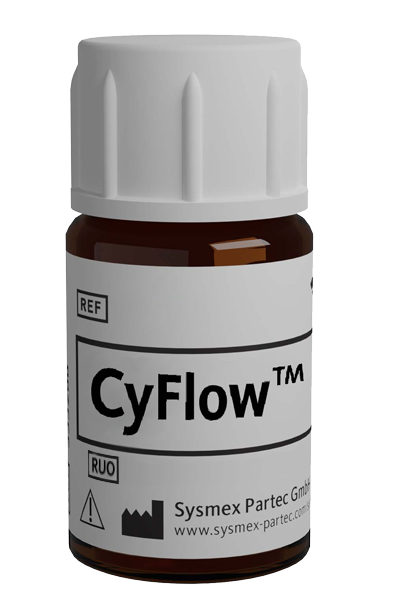CyFlow™ CD82 Biotin

| Alternative Name: | C33, R2l 4F9 |
| Antibody: | Yes |
| Antigen: | CD82 |
| Application: | Flow cytometry |
| Clonality: | monoclonal |
| Clone: | C33 |
| Field of Interest: | Immunophenotyping |
| Format/Fluorochrome: | Biotin |
| Isotype: | IgG2a |
| Regulatory Status: | RUO |
| Source Species: | Mouse |
| Target Species: | Human |
| Product number: | AV116998 |
For Research Use Only
| Concentration Unit | mg/mL |
| Concentration | 1 |
| Quantity | 0.1 mg |
| Volume | 0.1 mL |
| Immunogen | C91/PL (human HTLV-1+ T cell line) |
| Background Information | CD82 (KAI1), a member of the tetraspanin family, forms complexes with other tetraspanin proteins, integrins, coreceptors, MHC class I and II molecules. These complexes influence adhesion, morphology, activation, proliferation and differentiation of B, T and other cells. CD82 regulates cytoskeleton rearrangement and may participate in the turnover of the tetraspanin complex members. Besides in the plasma membrane, CD82 is localized also in endosome/lysosome compartments. Tumor-suppressive roles of CD82 have been demonstrated. |
| Usage | The reagent is designed for indirect immunofluorescence analysis by Flow Cytometry. Working concentrations should be determined by the investigator. |
| Storage Buffer | The reagent is provided in phosphate buffered saline (PBS) solution, pH ≈7.4, containing 0.09% (w/v) sodium azide. |
| Storage | Avoid prolonged exposure to light. Store in the dark at 2-8°C. Do not freeze. |
| Stability | Do not use after expiration date stamped on vial label. |
| Fukudome K, Furuse M, Imai T, Nishimura M, Takagi S, Hinuma Y, Yoshie O: Identification of membrane antigen C33 recognized by monoclonal antibodies inhibitory to human T‑cell leukemia virus type 1 (HTLV‑1)‑induced syncytium formation: altered glycosylation of C33 antigen in HTLV‑1‑positive T cells. J Virol. 1992 Mar; 66(3):1394‑401. < PMID: 1738199 > | Imai T, Yoshie O: C33 antigen and M38 antigen recognized by monoclonal antibodies inhibitory to syncytium formation by human T cell leukemia virus type 1 are both members of the transmembrane 4 superfamily and associate with each other and with CD4 or CD8 in T cells. J Immunol. 1993 Dec 1; 151(11):6470‑81. < PMID: 8245480 > | Imai T, Kakizaki M, Nishimura M, Yoshie O: Molecular analyses of the association of CD4 with two members of the transmembrane 4 superfamily, CD81 and CD82. J Immunol. 1995 Aug 1; 155(3):1229‑39. < PMID: 7636191 > | Ueda T, Ichikawa T, Tamaru J, Mikata A, Akakura K, Akimoto S, Imai T, Yoshie O, Shiraishi T, Yatani R, Ito H, Shimazaki J: Expression of the KAI1 protein in benign prostatic hyperplasia and prostate cancer. Am J Pathol. 1996 Nov; 149(5):1435‑40. < PMID: 8909232 > | Escola JM, Kleijmeer MJ, Stoorvogel W, Griffith JM, Yoshie O, Geuze HJ: Selective enrichment of tetraspan proteins on the internal vesicles of multivesicular endosomes and on exosomes secreted by human B‑lymphocytes. J Biol Chem. 1998 Aug 7; 273(32):20121‑7. < PMID: 9685355 >
